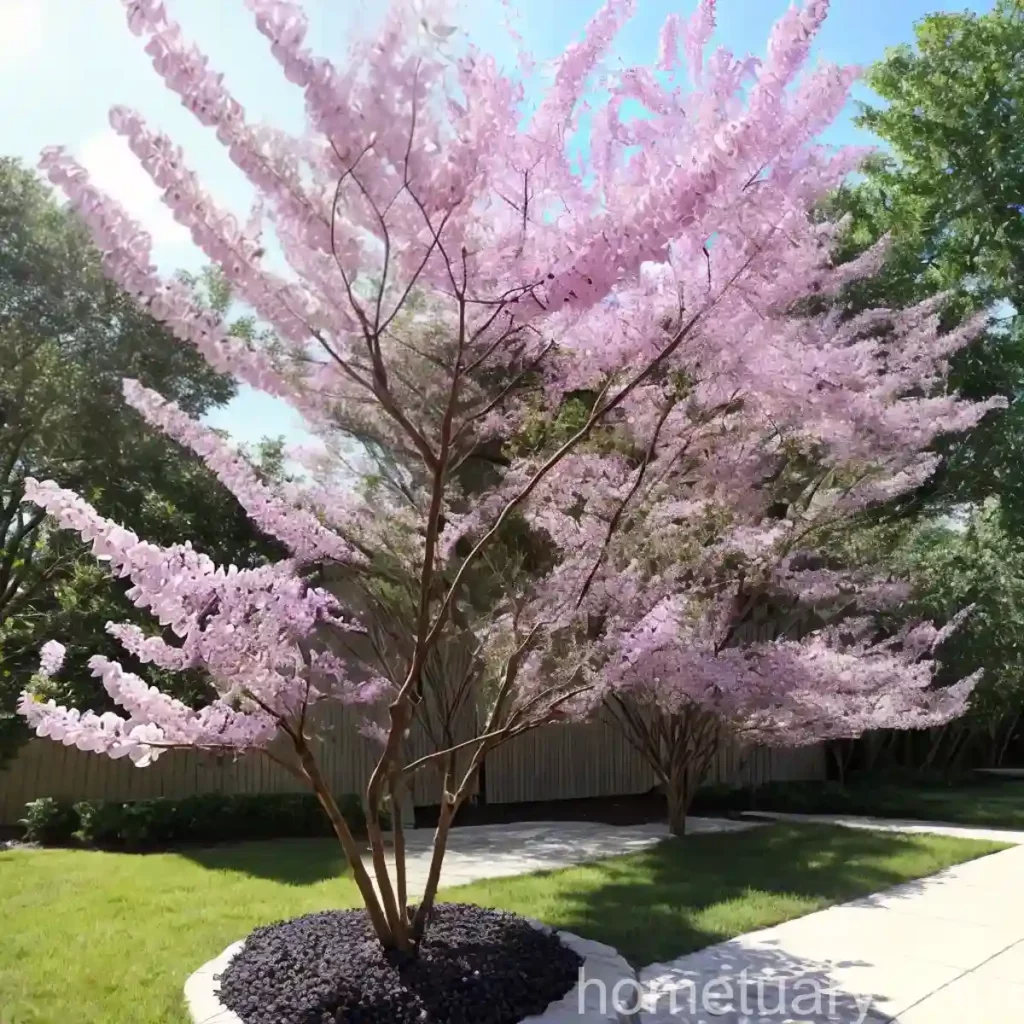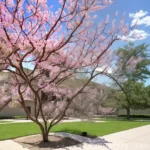Plant Profile: Eastern Redbud (Cercis canadensis ‘JN16’ BLACK PEARL)
In this blog post, we will explore the fascinating eastern redbud (Cercis canadensis ‘JN16’ BLACK PEARL), a beautiful ornamental tree cherished for its unique characteristics, cultural significance, and horticultural value.
Introduction to Eastern Redbud
The eastern redbud, scientifically known as Cercis canadensis ‘JN16’ BLACK PEARL, is a stunning deciduous tree native to North America. It is a member of the Fabaceae family and is revered for its ornamental value, particularly during the spring when it produces an extravagant display of pink to purple flowers on its bare branches before its foliage emerges. The ‘JN16’ BLACK PEARL variety is a cultivar known for its deeply colored, heart-shaped leaves and compact form, making it a sought-after choice for ornamental planting.
As we delve into the profile of the eastern redbud, we will explore its cultural preferences, uses, care requirements, and fascinating facts. Let’s embark on a journey to discover the allure of this captivating tree.
Key Takeaways – Eastern Redbud (Cercis canadensis ‘JN16’ BLACK PEARL)
Before we delve into the specific aspects of the eastern redbud, let’s highlight the key takeaways regarding this captivating plant:
- Scientific Name: Cercis canadensis ‘JN16’ BLACK PEARL
- Common Name: Eastern Redbud
- Family: Fabaceae
- Characteristics: Heart-shaped, deep purple leaves; pink to purple spring flowers; compact form
- Cultural Preferences: Well-drained soil, moderate watering, full to partial sunlight
- Uses: Ornamental planting, landscape enhancement
- Propagation: Seeds, cuttings
- Popularity: Widely favored for its ornamental value
- Common Diseases: Verticillium wilt, canker diseases
- Common Pests: Aphids, scale insects
- Botanist’s Tips: Pruning for shape and vigor, regular monitoring for diseases and pests
- Fun Facts: Valued for wildlife support, edible flowers
- External Resources: Links to valuable information and resources
Now, let’s delve into each of these aspects in detail to gain a comprehensive understanding of the eastern redbud.
What is Eastern Redbud?
The eastern redbud, Cercis canadensis, is a deciduous tree that typically grows to a height of 20 to 30 feet and spreads 25 to 35 feet. It belongs to the Fabaceae family and is native to eastern North America, from southern Ontario to northern Florida, and as far west as Texas. The tree is often found in open woodlands and along forest margins, showcasing its adaptability to a range of environments.
The ‘JN16’ BLACK PEARL cultivar of the eastern redbud is recognized for its exceptional ornamental features, including its deep purple, heart-shaped leaves and abundant display of pink to purple flowers in the early spring. These attributes make it a prized addition to gardens, parks, and landscapes, where it serves as a striking focal point.
The foliage of the eastern redbud further contributes to its ornamental appeal, transitioning to a dark green shade in the summer and culminating in a stunning display of yellow to red hues in the fall. The tree’s overall compact form and its ability to thrive in various soil types further enhance its desirability as an ornamental planting.
Culture
Water
The eastern redbud, including the ‘JN16’ BLACK PEARL cultivar, thrives in well-drained soil and requires moderate watering to establish and maintain healthy growth. During dry periods, particularly in the first few years after planting, it is essential to provide supplemental irrigation to ensure adequate moisture levels. Once established, the tree displays good drought tolerance, although consistent watering during prolonged dry spells can promote optimal performance.
Sunlight
For optimal growth and flowering, the eastern redbud favors full to partial sunlight. It flourishes in locations that receive ample sunlight, enabling it to produce an abundant and vibrant floral display in the spring. However, it can also tolerate partial shade, making it adaptable to various garden and landscape settings.
Fertilizer
During the initial stages of growth, it may be beneficial to apply a balanced fertilizer to support the eastern redbud’s establishment. However, once the tree is well established, minimal fertilization may be required, especially if it is growing in nutrient-rich soil. If necessary, a light application of a balanced, slow-release fertilizer in the spring can help maintain the tree’s vigor and overall health.
Soil
The eastern redbud, including the ‘JN16’ BLACK PEARL variety, thrives in well-drained soil with a preference for moderately fertile, loamy soil. It exhibits adaptability to various soil types, including clay, sand, and silt, as long as the soil offers adequate drainage. In addition, the tree shows resilience to slightly acidic to slightly alkaline soil pH levels, enhancing its adaptability to diverse environmental conditions.
Pruning
Pruning the eastern redbud, including the ‘JN16’ BLACK PEARL cultivar, is essential to maintain its shape, remove dead or diseased branches, and promote overall vigor. The best time to prune the tree is during the dormant season in late winter or early spring before new growth emerges. Care should be taken to avoid heavy pruning, as the tree’s distinctive form and natural elegance are integral to its ornamental value.
Propagation
The eastern redbud can be propagated through both seeds and cuttings. Propagation from seeds involves collecting ripe seeds in the fall and sowing them directly in the ground or in containers for subsequent transplanting. Stratifying the seeds before sowing can enhance germination rates. For propagation through cuttings, semi-hardwood cuttings can be taken in the summer and rooted in a well-draining propagation medium.
Uses
Ornamental Planting
The eastern redbud, especially the ‘JN16’ BLACK PEARL variety, is widely valued for its ornamental qualities. It serves as a delightful addition to residential landscapes, public gardens, and parks, where its vibrant spring flowers and striking foliage captivate onlookers. Whether planted as a standalone specimen, incorporated into mixed shrub borders, or utilized in woodland garden settings, the tree contributes to the visual appeal of its surroundings.
Landscape Enhancement
Due to its manageable size and attractive features, the eastern redbud is frequently employed in landscape enhancement projects. It thrives as a specimen tree in urban and suburban settings, where its ornamental attributes can be showcased effectively. Additionally, it can be utilized in group plantings or massed as an understory tree, providing visual interest and seasonal allure to the landscape.
Popularity
The eastern redbud, particularly the ‘JN16’ BLACK PEARL cultivar, has garnered widespread popularity within the horticultural community and among gardening enthusiasts. Its alluring qualities, including the unique coloration of its leaves, showy floral display, and adaptability to diverse growing conditions, have contributed to its appeal as a prized ornamental tree.
As gardeners and landscapers increasingly seek plants that offer both aesthetic appeal and environmental benefits, the eastern redbud has emerged as a favored choice for adding visual interest and ecological value to a wide range of outdoor spaces.
Common Diseases
The eastern redbud, like many ornamental trees, is susceptible to certain diseases that can impact its health and vigor. Understanding these common diseases and their symptoms is crucial for implementing preventive measures and timely treatments to ensure the tree’s well-being. Some of the prevalent diseases that may affect the eastern redbud, including the ‘JN16’ BLACK PEARL variety, are as follows:
-
Verticillium Wilt: This fungal disease can cause wilting, yellowing, and eventual leaf drop in affected trees. It is essential to monitor the tree for signs of wilting and undertake appropriate measures, such as improving soil drainage, to reduce the risk of infection.
-
Canker Diseases: Various types of canker diseases, caused by fungi or bacteria, can manifest as sunken, discolored areas on the tree’s branches or trunk. Pruning out affected branches and promoting optimal growing conditions can aid in managing canker diseases.
Disease Diagnosis
Symptoms
- Wilting or yellowing of foliage
- Sunken, discolored areas on branches or trunk
- Abnormal leaf drop
- Reduced vigor and growth
Diagnosis and Management
Diagnosing diseases in the eastern redbud necessitates keen observation of symptom progression and potential causal factors. Seeking professional advice from arborists, plant pathologists, or horticulturists can aid in accurate disease diagnosis and the implementation of effective management strategies, such as cultural practices, disease-resistant cultivar selection, and targeted treatments.
Common Pests
In addition to diseases, the eastern redbud, including the ‘JN16’ BLACK PEARL variety, can be susceptible to certain pests that may impact its health and appearance. Vigilant monitoring for signs of pest activity and implementing suitable control measures are essential for mitigating potential pest-related damage. Some of the common pests that may affect the eastern redbud include:
-
Aphids: These tiny insects may cluster on the tree’s tender shoots and foliage, feeding on plant sap and potentially causing distortion and discoloration of affected plant parts.
-
Scale Insects: Scale insects can infest the eastern redbud, appearing as small, immobile bumps on branches and stems. They feed on plant sap, potentially weakening the tree and promoting the development of sooty mold.
Botanist’s Tips
Pruning for Shape and Vigor
Regular pruning is pivotal for maintaining the eastern redbud’s distinctive form, removing dead or diseased branches, and fostering overall plant vigor. Pruning should be performed judiciously to preserve the tree’s natural appeal while ensuring good structural integrity and health.
Regular Monitoring for Diseases and Pests
Consistent observation of the tree for signs of diseases and pests is indispensable for early detection and prompt intervention. Implementing cultural practices that promote tree health, such as proper watering and soil management, can also aid in fortifying the tree against potential pest and disease pressures.
Fun Facts
-
Wildlife Support: The eastern redbud, including the ‘JN16’ BLACK PEARL variety, provides valuable support to wildlife, including bees, butterflies, and birds. Its nectar-rich flowers attract pollinators, and its seeds serve as a food source for various bird species.
-
Edible Flowers: The flowers of the eastern redbud are not only visually captivating but also edible, adding a touch of culinary appeal. They can be used as a decorative accent in salads, desserts, and other dishes, offering a unique culinary experience.
Links to External Resources
For further information and resources on the eastern redbud, including the ‘JN16’ BLACK PEARL variety, consider exploring the following links:
Plant Name: Cercis canadensis ‘JN16’ BLACK PEARL
Cultivation Guide: Eastern Redbud Cultivation Guide
Horticultural Information: Cercis canadensis LSI Keywords
Conclusion
The eastern redbud, encompassing the captivating ‘JN16’ BLACK PEARL variety, stands out as a cherished ornamental tree adored for its vibrant spring display, alluring foliage, and versatility in garden and landscape settings. By understanding its cultural preferences, uses, care requirements, and ecological significance, we can appreciate the distinctive allure of this remarkable tree.
Whether it graces residential gardens, urban parks, or natural landscapes, the eastern redbud continues to captivate with its visual splendor and ecological contributions. Understanding the nuances of its care and cultivation empowers enthusiasts and horticulturists to embrace and celebrate the enduring charm of the eastern redbud.
As we embrace the unique qualities and ecological value of the eastern redbud, we are inspired to foster a deeper appreciation for this iconic tree and its contributions to horticulture, ecology, and the natural world.
The captivating tale of the eastern redbud awaits discovery, inviting us to marvel at its seasonal transitions, cherish its ornamental grandeur, and revel in the harmony it brings to the outdoor landscape.
Thank you for joining me in this exploration of the eastern redbud, Cercis canadensis ‘JN16’ BLACK PEARL. As we conclude our journey, may the allure of this iconic tree continue to enrich our connection with nature and inspire us to cultivate beauty and harmony in the world around us.
Happy gardening!
This blog post was authored by a passionate plant scientist dedicated to the appreciation and conservation of plant life in the natural world.















